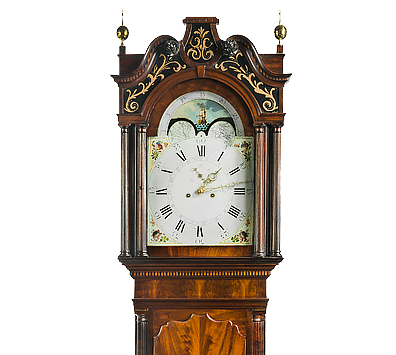Ansonia Clock History
 The Ansonia Clock Company was one of the major 19th century American clock manufacturers. It produced millions of clocks in the period between 1850, its year of incorporation, and 1929, the year the company went into receivership and sold its remaining assets to Soviet Russia.
The Ansonia Clock Company was one of the major 19th century American clock manufacturers. It produced millions of clocks in the period between 1850, its year of incorporation, and 1929, the year the company went into receivership and sold its remaining assets to Soviet Russia.
Here is a brief timeline describing the events leading to the formation of the Ansonia Clock Company and to its ultimate demise.
1844 – The Ansonia Brass Company is formed by Anson Green Phelps
Although he became one of the great mercantile capitalists of his time, Anson G. Phelps had rather humble beginnings. Born to an old Connecticut family, he was orphaned at age ten, and soon after became a saddlemaker’s apprentice. He later moved to Hartford and went into business for himself as a merchant and a shrewd trader. He bartered saddles for cotton from South Carolina and then sold the cotton in New York. With the proceeds from the cotton sales he purchased dry goods to sell back in his Hartford store.
At age 31 he moved to New York and joined forces with another Connecticut trader, Elisha Peck. As the firm of Phelps & Peck they exported Sourthern cotton to England and imported metals to New York in return, becoming New Yorks largest metal importer of the time.
After his partnership with Peck dissolved, he formed the firm of Phelps, Dodge & Co. with two of his son-in-laws. Phelps, Dodge and Co. remained a leading New York metals importer. Located in southeastern Connecticut’s Naugatuck River Valley on the east bank of the river, nine miles from New Haven, and the factory produced rolled brass for industrial uses. The city of Ansonia was originally part of a larger area called Derby. When the city was incorporated in 1889 it was named Ansonia in honor of Anson Phelps.
1850 – The Ansonia Clock Company is formed as a subsidiary of the Ansonia Brass Company by Phelps and two Bristol, Connecticut clockmakers, Theodore Terry and Franklin C. Andrews.
By 1838, inexpensive clock movements made of rolled brass had largely replaced wooden and cast brass movements in America. Terry & Andrews were the largest clock manufacturers in Bristol at that time. They had more than 50 employees and had used 58 tons of brass in the production of about 25,000 clocks in the previous year. Phelps decided to get into the clock making business as a means to expand his market for his brass products. It was a shrewd business move for Phelps to join forces with Terry and Andrews, allowing him to profit from the manufacture of a clock’s raw components and the finished product as well.
Terry and Andrews thought it was a good business decision for them as well, giving them ready access to large quantities of brass for use in clock movements. They agreed to sell Phelps a 50% interest in their clock making business and move the entire operation to Ansonia, CT, where Phelps had his brass mill.
1851 – 1852 Andrews leaves the business. In 1851 Andrews sells all but one of his shares. He sells his remaining share to Terry in 1852.
1853 Ansonia exhibits their cast iron cased clocks at the New York World’s Fair. Only two other American clock companies exhibited at the fair, which opened on July 4, 1853. They were the Jerome Manufacturing Company of New Haven, Connecticut, and the Litchfield Manufacturing Company of Litchfield, Connecticut.
1853 – Anson Phelps, at age 73, sells his interest in the Ansonia Clock Company to his son-in-law, James B. Stokes. Stokes was one of the directors of the firm of Phelps, Dodge & Co., a metal importing company originally founded by Anson G. Phelps and two of his son-in-laws. Phelps dies a wealthy man at his New York City home on November 30, 1853.
 [Early engraving of the original Ansonia Clock Factory in Connecticut]
[Early engraving of the original Ansonia Clock Factory in Connecticut]
1854 – A huge fire destroys the Ansonia Clock Company factory. The New York Daily Times reports at the time: “New Haven, Saturday, July 8 – The large stone factory of the Ansonia Clock Company was wholly destroyed by fire early this morning. The loss exceeds one hundred thousand dollars. Insured for about fifty thousand. The business of the company was conducted by T. Terry & Son.”
1854 – The land and the ruined buildings are bought by the directors of Phelps, Dodge & Co. The shares purchased include the remaining shares owned by the last of the original founders, Theodore Terry. It is interesting to note that Terry thereafter became involved in a clock venture with the great promoter P. T. Barnum. It produced clocks under the name of the Terry & Barnum Manufacturing Company until its bankruptcy in March of 1856.
1854 to 1869 – The Ansonia Brass & Battery Mill, one of Phelps, Dodge & Co. subsidiary companies, continues to make brass movements for supply to the general clock making trade. They also made some finished clocks that were usually marketed under the label “Ansonia Brass Company” and, more rarely, the “Ansonia Brass & Battery Company” In 1860 they report having manufactured 22,000 clock movements and 2,000 finished clocks during the previous year.
1869 – Full-scale clock production resumes under the name of the newly incorporated Ansonia Brass & Copper Co., a reorganization of the Ansonia Brass & Battery Company. By June of 1870, the company reports it had manufactured 83,503 clocks. By this time the factory employed 150 workers and had used 90,000 pounds of brass in making the clocks. The earliest known price list under the Ansonia Brass & Copper Company name, dated January 1, 1873, offers 45 models of clocks and timepieces and fourteen different movements.
1877 – The Ansonia Clock Company is reborn when the clock making operation is spun off from the brass milling operation. The company is incorporated in New York City, its shares held primarily by the officers of Phelps, Dodge & Company. Henry J. Davies of Brooklyn, himself a clockmaker, inventor and case designer, joins the newly reconstituted company as one of its founders. As President of the firm he makes great contributions to its success. He is thought to be largely responsible for the figurine clocks, swing clocks and other unusual and desirable novelties for which the Ansonia firm became known, and which are among today’s most collectible of Ansonia clocks.
1878 – Inventor Thomas Edison visits the Ansonia Clock Company factory to experiment in combining clocks with his newly developed phonograph. Edison and his principal lab assistant, Charles Batchelor, did some of the initial experiments, leaving the Ansonia Clock Company to continue with the bulk of the research and development. Attempts to make a commercially viable “phonograph clock” proved ultimately unsuccessful.
1879 – A second Ansonia Clock factory is opened in Brooklyn, New York. By June of 1880 it has 360 workers. The Ansonia, Connecticut factory continues producing clocks as well with a work force of 100 men and 25 women.
A postcard view of Ansonia Clock Factory, Brooklyn, New York, 7th and 8th Aves. and 12th and 13th Sts. “Largest Clock Factory in the World”
A postcard view of Ansonia Clock Factory, Brooklyn, New York, 7th and 8th Aves. and 12th and 13th Sts. “Largest Clock Factory in the World”
1880 – Misfortune strikes again when the New York factory burns down. The cause of the fire is reportedly an explosion caused by leaking gas. The New York Times reported: “all that remained of the factory was the burned and blackened walls.” The loss is reported to be $750,000 with only $250,000 insured.
1881 – The New York factory is rebuilt on the same site.
1883 – The Ansonia, Connecticut factory is closed. All administrative and manufacturing operations are moved to New York. By this time Ansonia had sales offices in New York, Chicago and London.
1886 – By now more than 225 different clock models are being manufactured. The prosperous and debt free Ansonia Clock Company reports having an inventory worth $600,000 and receivables valued at $250,000.
1904 – Ansonia adds inexpensive, non-jeweled watches to their line. Ansonia had produced an estimated 10 million of these by 1929.
1914 – The company is at its height. More than 440 different clock models are now available. In addition to a huge domestic sales volume, clocks were exported in large quantities to Australia, New Zealand, Japan, China, India and eighteen other countries.
1915 to 1920 – Sales volume drops as the effects of WWI and stiff competition from other clock companies begins to take its toll. In the early 1900’s Ansonia’s line of novelty clocks became their biggest sellers. However, as competition for the novelty clock market grew ever stronger, the company attempted to maintain their market share by undercutting their competitors’ prices. This strategy proved financially disastrous. By failing to maintain a realistic profit margin the company took on increasing debt, all the while failing to curb the competition in the niche they once dominated. By 1920, the number of clock models offered in their catalogs had dropped to 136. Their formerly popular black iron mantel clocks, china cased clocks and statue clocks were all discontinued.
1926 – Ansonia sells it five story Brooklyn warehouse.
1927 – The number of different Ansonia clock models offered for sale drops to 47.
1929 – The company goes into receivership a few months before the stock market crash. The machinery and dies were sold to Amtorg, an American trading organization acting as the principal importing and exporting agent for Soviet Russia. An October 10, 1929 news story in the Appleton Post Crescent of Appleton, Wisconsin, mentions the event in an article titled “Soviet Russia Is Good Customer of U.S. Businessmen – Purchases Four Times Above Pre-War Acale and Still Going Up.” The article begins:
“American goods and manufacturing, engineering and building talent continue to pour into Russia with increasing volume. Russia ’s five year plan of economy and industrial expansion is being revised ambitiously…A check of the facts and figures seems to indicate that Russia is determined to build up her whole economic structure with American parts.”
The article continues with the mention of the Ansonia Clock Company as one of its purchases:
“(Russia) has just bought a clock factory from the Ansonia Clock Company of Brooklyn which will be moving to Russia to manufacture a million alarm clocks and half a million wall clocks a year.”
The deal included sending former Ansonia employees to Moscow for up to 18 months set up the equipment and train Russian workers, giving birth to Russia’s industrial mass production of mechanical timepieces.
The Lima (Ohio) News gave this account in a March 12, 1931 news report:
“…there came an order to supply the Soviet union with men and machines to make watches and clocks, neither of which products ever had been manufactured there. Representatives of Amtorg went to the Ansonia Clock Company in Brooklyn and to the Duber Hampden Watch Company of Canton, Ohio, and bought them lock, stock and barrel. Then they hired most of the skilled employees of the plants to go to Russia and operate the familiar machines. These have been installed in a new, many-windowed building in Moscow, where Russian apprentices are beginning to master the trade.”

Ship Your Clock for Expert Repairs!
Expert Shipping Instructions!

Grandfather Clock Service Calls
We make Grandfather Clock service calls!

Contact Us
Feel free to contact us any time at (215) 862-2415.

Further Questions?
We'd like to hear from you!
People Say




